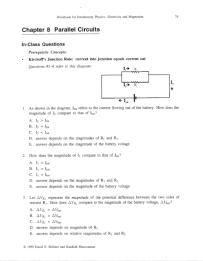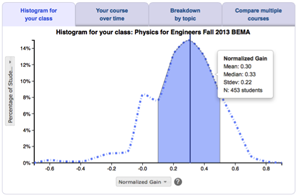
Developed by: David E. Meltzer and Kandiah Manivannan





middle schoolhigh schoolintro collegeinter-mediateupper levelgrad school other

calc based

alg based







Overview
What? Sequences of multiple-choice questions that emphasize qualitative reasoning and multiple representations. For interactive discussion in large lecture classes with clickers or flashcards. Accompanied by lecture notes, exams, and free-response worksheets. Designed for students with less preparation.
Why? Similar to Peer Instruction, but includes a higher proportion of interactive activities, and a full set of materials for an intro E&M course. The conceptual "step-size" from one question to the next is relatively small, offering a more gentle approach for students with limited preparation.
Why not? Materials are only available for the second semester of intro physics. This is a band-aid on a traditional lecture course structure, which is less ideal than making a more drastic change to your course structure and engaging students in working on longer and more meaningful problems.
Activity outline
A typical class has three phases:
- Mini-lecture: Brief introduction/review of the basic concepts (3–7 minutes).
- Interactive questions: A sequence of multiple-choice questions posed to the class. These emphasize qualitative reasoning, proceeding from relatively simple to more challenging, and are closely linked to each other to explore one or two concepts from a multitude of perspectives, using a variety of representations. Students provide responses by using the flash cards. Brief free-response exercises, for example, drawing simple diagrams or performing elementary calculations, are interspersed.
- Follow-up activities: Interactive demonstrations, group work using free-response worksheets, or another mini-lecture and question sequence.
From D. Meltzer and K. Manivannan, Transforming the lecture-hall environment: The fully interactive physics lecture, Am. J. Phys. 70 (6), 639 (2002).
Topic outline
Chapter 1: Electric Charges and Forces
Chapter 2: Electric Fields
Chapter 3: Electric Potential Energy
Chapter 4: Electric Potential
Chapter 5: Current and Resistance
Chapter 6: Series Circuits
Chapter 7: Electrical Power
Chapter 8: Parallel Circuits
Chapter 9: Magnetic Forces and Magnetic Fields
Chapter 10: Magnetic Induction
Chapter 11: Electromagnetic Waves
Chapter 12: Optics
Chapter 13: Photons and Atomic Spectra
Chapter 14: Nuclear Structure and Radioactivity
Student skills developed
- Conceptual understanding
- Using multiple representations
- Problem-solving skills
- Metacognition
Instructor effort required
- Medium
Resources
Teaching Materials
You can download a full set of materials for an introductory E&M course, including sequences of multiple-choice questions that emphasize qualitative reasoning and multiple representations, lecture notes, exams, and free-response worksheets, for free from the developer's website. The developers do not provide materials for introductory mechanics because they rely more heavily on other published materials, such as Knight's Student Workbook for Physics and the Tutorials in Introductory Physics.
You can download a sample series fo questions from PhysPort.
Research
This is the third highest level of research validation, corresponding to:
- at least 1 of the "based on" categories
- at least 1 of the "demonstrated to improve" categories
- at least 1 of the "studied using" categories
Research Validation Summary
Based on Research Into:
- theories of how students learn
- student ideas about specific topics
Demonstrated to Improve:
- conceptual understanding
- problem-solving skills
- lab skills
- beliefs and attitudes
- attendance
- retention of students
- success of underrepresented groups
- performance in subsequent classes
Studied using:
- cycle of research and redevelopment
- student interviews
- classroom observations
- analysis of written work
- research at multiple institutions
- research by multiple groups
- peer-reviewed publication
References
- K. Manivannan and D. Meltzer, Use of In-class Physics Demonstrations in Highly Interactive Format, presented at the Physics Education Research Conference 2001, Rochester, New York, 2001.
- D. Meltzer, Formative assessment materials for large-enrollment physics lecture classes, presented at the National Stem Assessment Conference, Washington, D.C., 2006.
- D. Meltzer and K. Manivannan, Transforming the lecture-hall environment: The fully interactive physics lecture, Am. J. Phys. 70 (6), 639 (2002).





